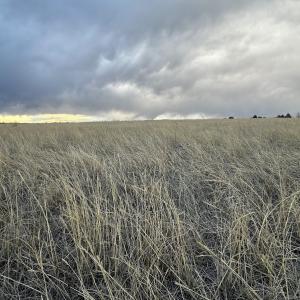A Climate Adaptation Menu for North American Grasslands
Date
North American grasslands, which span vast territories across the continent, are important yet often overlooked ecosystems in climate policy and conservation efforts. These landscapes play a crucial role in maintaining biodiversity, sequestering carbon, preventing soil erosion, and regulating water cycles. Approximately half of the original grasslands have been lost due to a range of pressures, including agricultural expansion, energy development, woody plant encroachment, urban growth, and intentional afforestation. In addition to this loss, many remaining grasslands have been further degraded by invasive species, fire suppression, and uniform grazing practices that reduce ecological diversity. In response to these challenges, Bernath-Plaisted et al. (2025) developed the Grassland Adaptation Menu, a structured guide designed to support managers in implementing climate resilience strategies tailored to grassland ecosystems.
Grasslands store approximately 30–35% of the world’s terrestrial carbon, with nearly 90% of it retained in the soil. This unique carbon sequestration function makes them invaluable in climate change mitigation efforts. Furthermore, they support pollination, enhance water filtration, and provide critical habitats for numerous species. Despite this, grasslands remain underrepresented in climate adaptation policies and research. Current climate projections indicate that North American grasslands will face severe disruptions in the coming decades. Rising temperatures, prolonged droughts, erratic precipitation, and increased frequency of extreme weather events threaten the stability of these biomes. The Central Grasslands region, a vast area of primarily prairie and steppe ecosystems stretching through the central part of North America, is expected to experience a temperature rise of at least 4°F by mid-century, alongside altered precipitation patterns that could exacerbate moisture deficits. Such changes will profoundly impact grassland productivity, species distribution, and ecosystem resilience. Given these mounting threats, conservationists must develop proactive and adaptive management strategies to ensure the long-term viability of these ecosystems.
While climate change research in grasslands has increased, only a small percentage of studies provide actionable recommendations for land managers. The Grassland Adaptation Menu helps to bridge this gap by distilling complex ecological concepts into structured, evidence-based guidelines. It was developed through a systematic literature review and expert consultation with land managers across North America. The goal was to create an actionable, hierarchical framework. The menu consists of eight overarching strategies that encompass 32 targeted approaches and 145 specific management tactics, providing a clear roadmap for implementing climate adaptation in grassland ecosystems. Some of the key strategies and adaptation approaches include restoring and maintaining grassland extent by prioritizing conservation of existing grasslands in future climate refugia; preventing land conversion by regulating energy leases and incentivizing sustainable land use; and promoting heterogeneous landscapes through patch-burn grazing and strategic land restoration. Enhancing landscape-scale resilience can be accomplished by establishing movement corridors and stepping stones to facilitate species adaptation; protecting habitat edges to support shifting species distributions; and promoting prairie strips and native vegetation buffers to increase connectivity. Fundamental ecosystem functions can be maintained by restoring natural fire and grazing regimes to sustain soil health and nutrient cycling; using biochar and soil amendments to enhance carbon sequestration and moisture retention; and managing hydrology to maintain grassland-embedded wetlands and water sources. Increasing biodiversity and structural heterogeneity can be achieved through utilizing diverse seed mixes from multiple climate zones to enhance genetic diversity and creating microclimate refuges by supporting taller vegetation and restoring topography. Facilitating climate-driven ecosystem transitions includes species range shifts through assisted migration and habitat modifications; identifying and prioritizing conservation areas that will remain climatically suitable for key species; and converting marginal croplands back to grasslands where agricultural viability declines. Finally, engaging human communities in grassland conservation includes integrating Indigenous knowledge into adaptation planning and land stewardship; developing economic incentives, such as carbon credit programs and sustainable grazing certifications; and encouraging public participation in conservation efforts through citizen science and community-led restoration projects.
A key aspect of the Grassland Adaptation Menu is its flexibility and applicability at different spatial scales. The Nature Conservancy (TNC), one of the NC CASC’s consortium partners, demonstrated its practical use by applying it to the Samuel H. Ordway Prairie and the Leola Hills Conservation Area in the Northern Great Plains. This region faces multiple climate-driven challenges, including increasing temperatures, shifting precipitation patterns, and heightening agricultural pressure. Using the adaptation framework, TNC identified important climate adaptation approaches including adjusting prescribed burn schedules to accommodate changing seasonal conditions; enhancing seed-sourcing diversity by incorporating climate-adapted plant genotypes; improving hydrology management to counteract moisture deficits and soil degradation; and developing outreach programs to educate and incentivize private landowners in conservation efforts. This case study highlights how the Grassland Adaptation Menu can serve as a valuable tool for guiding on-the-ground management decisions while aligning with broader climate adaptation goals.
As climate change accelerates, grassland conservation must evolve to meet emerging challenges. To further improve the integration of science into conservation practice, researchers are encouraged to clearly outline management implications in their studies, engage directly with land managers to co-develop adaptive strategies, and provide accessible summaries and decision-making tools to translate research into practice. The Grassland Adaptation Menu provides this kind of structured, science-driven approach to enhancing climate resilience, in this case in North America's grasslands. By implementing diverse adaptation strategies—from preserving future refugia to fostering biodiversity and engaging communities—grassland managers can ensure the long-term sustainability of these critical ecosystems. This study serves as a call to action for policymakers, conservationists, and landowners to prioritize adaptation efforts with proactive planning and collaborative management. As co-author Marissa Ahlering (The Nature Conservancy) states, “The impacts of climate change are complicated to predict and the number of different possible futures given uncertainty in models and emissions scenarios can make it feel overwhelming to identify effective climate adaptation actions. The Grassland Adaptation Menu eases this process by compiling into one place commonly used and suggested adaptation approaches. While climate impacts may be different everywhere, many of the same approaches may be useful in promoting ecosystem adaptation in different places. Having a proven base of adaptation actions to start from is helpful.”


